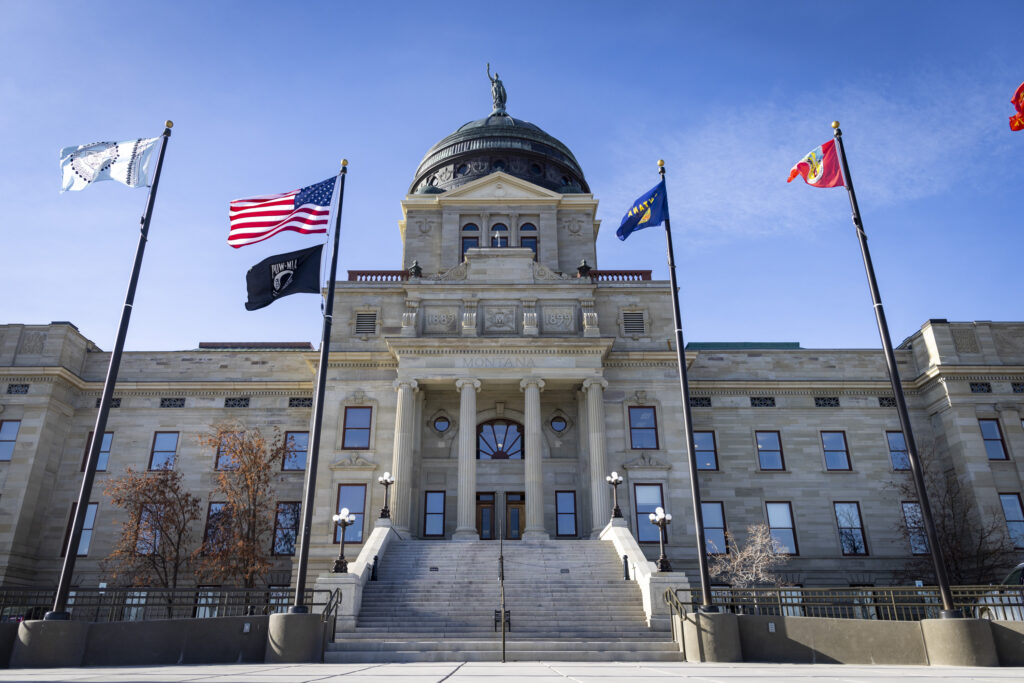The Montana State Capitol in Helena on Wednesday, April 26, 2023. (Photo by Mike Clark for the Daily Montanan)
A couple of legislators asked Wednesday why the Department of Public Health and Human Services cut nearly $1 million from a child care budget that helps families.
They also wanted to know if the decision to award another contract — to support child care providers — to an out-of-state entity instead of Montana businesses is part of a trend.
“Why did we have to go with the out-of-state contractor?” said Rep. Mary Caferro, D-Helena. “It just seems not right to send our tax dollars out of state.”
At the legislative budget committee meeting, a couple of members of the public raised concerns as well.
The questions came soon after the state broke up a bundle of services related to supporting families and child care facilities.
In a recent email about the changes, a DPHHS spokesperson said the goal is to provide even more support to children and families, including with growth in quality programs, retention of child care businesses, and additional openings at child care facilities.
In the past, DPHHS had six separate contracts with regional organizations that provided a variety of support. For one, they helped families figure out how to pay for child care, including whether they qualified for the Best Beginnings scholarship.
Now, just two organizations will do that work; a third backed out and is in limbo because it could not afford to do the job at the reduced level of funding from the state, an estimated 27% cut from $3.4 million, according to an earlier estimate.
Additionally, the regional organizations helped child care facilities function, but now, New York-based Acelero Inc., or Shine Early Learning, is slated to do that work.
Shine did not respond to earlier questions from the Daily Montanan.
Cicely Podgorski, a child care provider in Butte, told the committee she had called Shine as well, and no one picked up the phone or responded to her message even after two weeks.
In the past, she’s received help from Butte 4 C’s, she said. It won’t be doing the work anymore, but Podgorski said “boots on the ground” are needed for the critical services.
Montana is rural, she said, and not everyone has access to the internet and can work via Zoom.
“I have been in business for almost three years now, and without the local support that I received from the Butte 4 C’s, I would not be here with that day care,” Podgorski said.
At the hearing, DPHHS’ Jessie Counts said Shine will provide some services virtually, but it also will establish a physical footprint in Montana and hire 10 Montana staff.
The 10 hires will account for some, but not all, of the projected losses in Montana.
One organization, Child Care Connections in Bozeman, has 16 staff, and it’s in limbo; 4 C’s in Butte will lose eight to 10 of its 18 workers as a result of the changes, the directors said earlier.
In the past, Montana organizations provided services to both families and facilities, and their directors said the ability to do both helped make overhead costs more affordable. But they said that’s no longer an option.
At the meeting, Sen. Chris Pope, D-Bozeman, said he sensed a “sea change” in the way the state of Montana is doing business, allowing large out-of-state providers to compete for work local providers used to do. He said he wanted to know if the effects had been studied.
“Is this something that is going to bring more efficiency? Better results, outcomes? Things that we care about here?” Pope said.
DPHHS Director Charlie Brereton said he would not characterize the recent changes as part of a “sea change,” and the Health Department continues to adhere to Montana’s competitive process for contracting.
Counts also said DPHHS broke up contracts because doing so allows for improved “monitoring and accountability.”
In an email about the changes, DPHHS Jon Ebelt said the providers didn’t bill for the full $3.4 million on the provider contract either. He also said the goal is to help even more children and families in the future.
“The new contracts will be built on a pay-for-performance model with the ultimate goal of increasing access to child care in Montana,” Ebelt said.
Those indicators include opening up more child care slots, retaining child care businesses, and processing more Best Beginnings scholarships, among other criteria.
At the meeting, however, Caferro said local organizations in Montana have spent decades building their businesses, and she’s disappointed the state changed the model on them. She also wanted to know how just two organizations could do the work six used to do and with so much less money.
“I’d be curious if you could help me understand how they will be expected to do more with less,” Caferro said.
Counts said DPHHS looked at how much money was going to be used, and it was less than the original $3.4 million. She said the state also looked at where it could appropriately redistribute funds, and it set a request for proposals to match.
“We were able to find offers within that budget,” Counts said.
In public comment at the end of the hearing, however, Casey Nichols, who said Podgorski is his sister, questioned the lack of rationale from DPHHS about why the contract is going to a New York outfit.
“There’s no answer despite two questions up here on what the company is doing better than our previous system,” Nichols said.
He said if DPHHS is going to consider out-of-state corporations, those companies need to have clearly stated goals about how they will help Montanans. If the state could reverse course, he said, he encouraged it to do so.
He also said a “very small budget savings” was not reason enough.
“What price do we put on our Montana values and the established system?” Nichols said.
The changes are scheduled to take place Oct. 1.

